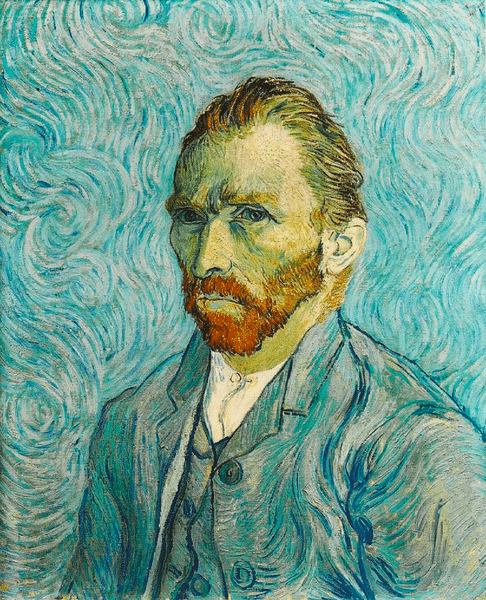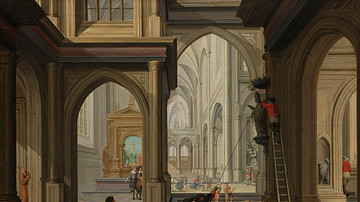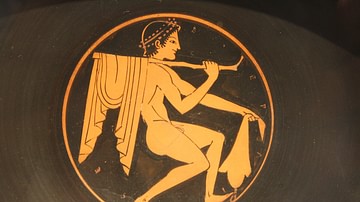
Vincent van Gogh (1853-1890) was a Dutch post-impressionist artist whose paintings are amongst the most popular and recognizable in history. His dramatic brushwork, exuberant palette, and mastery at capturing moments in time and light revolutionised art. Only recognised at the end of his life, his struggles and triumphs have coloured exactly what we imagine it is to be an artist.
Works like Sunflowers, Café Terrace at Night, and The Starry Night have transcended the world of painting to become iconic symbols, not only of a single artist but a whole time period and art movement. Van Gogh's unique way of looking at the world was ahead of its time with the consequence that, unable to earn a living from his work or reconcile his doubts as to the value of his achievements and overcome his mental crisis, he committed suicide, alone and penniless. Not only did van Gogh leave the world the great gift of his visionary paintings but his letters, written to his younger brother Theo (1857-1891) and others, give us a fascinating and, at times, heartbreaking insight into how Vincent battled rejection, indifference, and self-harm to achieve his goals in art and life.
Van Gogh painted around 870 oil paintings in his short career, as well as sketches and watercolours. In addition, we have a tremendous amount of detail on what Vincent got up to when he was not painting thanks to him being a prolific letter writer. The artist wrote over 650 letters to Theo, and 41 replies survive from Theo. His younger brother helped him financially and with materials throughout his career; he also gave advice regarding his art and kept Vincent up-to-date with developments in the art world. Another 100 or so letters survive written to other relatives and artists. Many letters contain sketches that can reveal the planning stage of paintings and their dates. Then there are the 43 self-portraits. Neither the letters nor the portraits are unbiased, naturally, but they mean we can pursue the career of the artist from multiple directions besides mere paint and canvas.
Early Life
Vincent Willem van Gogh was born on 30 March 1853 in Groot-Zundert, the Netherlands. His mother was Anna Cornelia Carbentus (1819-1907) and his father, Theodorus (1822-1885), was a pastor in the Dutch Reformed Church. Significantly, three of Vincent's uncles worked in the art trade. Vincent did well at school in Zevenbergen and Tilburg, and he took an interest in drawing. His drawing master at Tilburg, C. C. Huysmans, not only encouraged Vincent to copy old paintings, as was standard practice, but also, unusually, to copy nature. None of his surviving early drawings suggests the great talent within. In July 1869, Vincent joined the firm Goupil & Cie in the Hague branch. The company sold art prints and originals. Vincent did well, and in January 1873, he was transferred to the Brussels branch. In June, he moved to the London branch. Vincent continued to sketch, visited the capital's many galleries, and developed a taste for English poetry.
Between 1874 and 1875, Vincent transferred to the Paris branch of Goupil's, then returned to London, then was back in Paris. All was not well, and he was dismissed in the spring of 1876. Next followed a teaching post in Ramsgate, England, and then a teaching role under the auspices of a Reverend Jones, which saw him preach in various villages outside London. Unable, it seems, to settle anywhere for very long, Vincent next turned up selling books in Dordrecht as 1876 came to a close. By now intent on a career in the Church, Vincent moved to Amsterdam in May 1877 to prepare for the theological entrance exam. Meanwhile, he continued to sketch, this time focussing on landscapes.
Van Gogh seems to have been determined to bring some kind of religious consolation to the peasantry, and in July 1878, he tried to become an evangelical missionary. Spending three months training in Brussels, Vincent was a poor speaker and was not given a post, but he went anyway to a mining town in the Borinage region of Belgium in December 1878. Eventually gaining official support, Vincent then promptly lost it in July 1879 when it was discovered he had given away practically all of his belongings to the poor. Vincent continued on his one-man mission for another 12 months until his religious zeal was quenched. His art continued in sketch form, especially of miners, and he studied art theory books to improve his draughtsmanship. At some point in 1879, he made the definitive decision to become a full-time artist. By October 1880, he was back in Brussels and hoping to join the Academy of Art there, but he soon ran out of cash and was obliged to return to his parents' home in Etten in April 1881. By 1882, a trip to The Hague and his artist cousin Anton Mauve (a prominent member of The Hague School) had given Vincent the courage to begin to paint in watercolours, a move encouraged by Theo. It was in this period that Vincent's advances towards his cousin Kee Vos-Stricker were rebuffed. A brief visit home ended with a quarrel with his father, possibly over Vincent not wanting to attend church anymore. Back in The Hague and with the help of Mauve, Vincent set up his first studio.






Vincent van Gogh: A Gallery of 30 Paintings
A Full-time Artist
With his attic studio at Shenkweg, The Hague, Vincent began to use as a model a seamstress and former prostitute, Clasina Maria Hoornik (called Sien). Vincent and Sien then lived together, the artist also supporting Sien's mother and his model's two children, an act of kindness which neither his parents nor fellow artists in The Hague approved of. Cousin Mauve withdrew his support, perhaps not impressed with Vincent's progress and after the two had argued on how to improve the technical side of his drawing. Vincent continued his own methodology, studying illustrations and experimenting in lithography. One typical sketch of this period is an old man with his head in his hands in despair; Vincent gave it the title At Eternity's Gate. A mark of his progress was a commission from his uncle Cornelis Marinus for a series of views of The Hague. Then, a visit from Theo in August 1882, who brought him the supplies, led to a move into oil painting. This was a risk since oil paints were expensive, but Vincent persevered, and his letters show that he revelled in the exploration of colours.
Theo was now essentially paying for Vincent's living costs, and to lessen the burden in September 1883, the artist moved to a cheaper location, Drenthe, leaving behind Sien. Not staying long, Vincent moved around the Netherlands, painting landscapes and labourers at work in the fields.
In December 1883, Vincent was back with his parents at Nuenen, although his studio was in the village. Theodorus van Gogh died in March 1885, and this put further strain on the artist's relationship with his family. He continued to paint, notably winter scenes and local weavers. A commission came for six sketches of peasant life, an all too rare case of Vincent contributing to his living costs, which were now being met by Theo with regular monthly payments. Another small source of cash was Vincent teaching a handful of local artists. Another episode of unrequited love hit Vincent when his marriage proposal to Margot Begemann, a neighbour, was refused, largely because of the disapproval of her family. Artistically, Vincent's work was maturing, and in April 1885, he produced his first great canvas, The Potato Eaters, a work he himself highly valued. He was also experimenting with brighter colours. In November 1885, Vincent was looking for new ideas, and he left for Antwerp, then in March 1886, after an unsuccessful stint studying at the Academy, he moved on to the very centre of the European art world in the late 19th century: Paris.
Paris
Vincent joined up with Theo in Paris, and the pair shared an apartment for the next two years. From his arrival in March, Vincent visited galleries, and he learnt first-hand from fellow artists of the new movement in art – impressionism – and its preoccupation with light and capturing a particular scene at a particular moment with quick brushstrokes and dramatic colours. Vincent studied under the painter Félix Cormon, copying plaster casts and exploring colours in still life works of flowers. He also encountered the Japanese prints that had become popular in Europe and which he greatly admired for their boldness of colour and composition. He painted panoramas of Paris, especially Montmartre, a whole series of windmills, and the first of his many self-portraits.

Vincent struggled to get any of his paintings exhibited, except by friends of the impressionists like "Père" Tanguy (1825-1894), who owned an art supplies shop in Montmartre, accepting paintings as payment for materials. Vincent painted Tanguy three times. Vincent organised his own exhibition of modern artists in the rooms of a restaurant in November-December 1887, showing many of his own paintings and by fellow artists like Paul Gauguin (1848-1903) and Henri de Toulouse-Lautrec (1864-1901). A few of the other works were sold, but none of Vincent's. The artist did sell a still life to a dealer in this period, and he often paid for meals in cafés by giving the proprietor a painting. His now-famous Self-portrait with Grey Hat (1887-8) belongs to this period, and the bold brushstrokes and use of colours demonstrate what is yet to come.
Southern France
Tired of the rivalry between artists in Paris and seeking warmer weather to boost his frail health, Vincent moved to Arles in the south of France in February 1888, where he began by far the most productive period of his career, rattling off countless paintings. While not isolated from company, Vincent did struggle to make meaningful relations with southern artists. Instead, he befriended people like Joseph Roulin, the local postman who he painted several times.
"In my picture of the Night Café, I have tried to express the idea that the café is a place where one can destroy oneself, go mad or commit a crime" Van Gogh (LT, 534F)
Vincent was impressed with the sunlight of southern France, and his palette was now bright and bold. The subjects are much simpler in composition than previous works (although he curiously ignored the many Roman ruins of the region). In the spring, he captured blossom trees in works like Pink Peach Trees. As summer came on, the sun and yellow fields were brilliantly captured in such works as the Sower with Setting Sun. He painted seascapes and captured more local colour at Sainte-Maries-de-la-Mer. Arles, though, dominates with scenes depicted in fiercely contrasting and saturated colours like the yellow and blue of the Café Terrace at Night and the red and green of The Night Café. By August, he had begun his startling series of sunflowers, created as a mere decoration for his home, the Yellow House. September's Starry Night over the Rhône shows that the artist is undaunted by the practicalities of impressionistic plein air (open-air) painting. His colours are now intense, the form and space are often exaggerated. Vivid monochrome backgrounds, often textured to contrast with the smoother main subject, mix with swirling brushstrokes of liberally-applied paint. He has blended impressionism with symbolism, where a painting is created to provoke the imagination and prompt an emotional response from the viewer. The inimitable van Gogh style has arrived.

Mental Instability
Vincent hoped to form an artist's community in Arles, and he invited such young painters as Gauguin and Emile Bernard (1868-1941). The former did come to Arles in October 1888, and the pair lived and worked together, both funded by Theo. The two painters influenced each other – Vincent's bright colours on Gauguin's palette, and Gauguin's encouragement that the Dutchman experiment with different subjects. Cooped up indoors as the mistral wind blew, the two strong characters often clashed, especially over art; Vincent described their arguments as "electric," and Gauguin describes even threats of violence. The crisis came on 23 December. After yet another argument, Gauguin spent the night in a hotel, and when he returned to the Yellow House the next morning, he was surprised to see the police. During the night, Vincent had cut off a part of his ear and presented it to a local prostitute. He was sent to hospital, and Theo was summoned from Paris. Gauguin left Arles immediately after the incident. Vincent put the attack down to a fever and lack of nutrition; by January, he was back painting, but more attacks of his illness, whatever it was, would follow.
In May 1889, Vincent voluntarily admitted himself to the asylum of Saint-Paul-de-Mausole in Saint-Rémy-de-Provence. Still the artist suffered attacks, but in between, he was permitted to continue painting. Like his spirits, Vincent's palette is now noticeably muted. Perhaps this return to more sober works was an attempt to recapture his earlier ambition of becoming a painter of northern peasant life. It may also be significant that he now created a new version of The Potato Eaters. Doctors at the asylum diagnosed the artist's illness as epilepsy. Studies in the 20th and 21st century have come up with other theories for the artist's mental instability, notably schizophrenia or the effects of syphilis (he was treated for a venereal disease while in The Hague) or overconsumption of absinthe or a combination of all four maladies. In his own letters, Vincent mentions "the artist's madness" (LT 574), but he makes little connection between his illness and his work; he treats them as being quite independent.
Making some improvement healthwise, Vincent was permitted to paint in the nearby fields and olive orchards, but another attack occurred during which he ate some of his oil paints. Intermittent attacks followed through to February 1890, and the recovery periods lengthened. In May 1890, following consultation with Theo and on the advice of Camille Pissarro (1830-1903), Vincent went to consult with Dr Paul Gachet (1828-1909) in Auvers-sur-Oise in northern France. Gachet was a physician, heart specialist, and advocate of homoeopathy, he was also a good friend of the impressionists. Vincent stayed in a local inn and regularly visited Gachet, painting his portrait and the many flowers in his garden. Perhaps sensitive to an end of things, the artist was more prolific than ever, painting a new canvas almost every day.
Death & Legacy
On 27 July, van Gogh, after painting in a field, suffered another attack. He shot himself in the chest with a pistol but managed to drag himself back to his inn. Theo was once again called. Vincent was still alive when his brother arrived, but he died from his wound in the morning of 29 July. An added tragedy was that the artist was just beginning to arouse the interest of art critics. A few months prior to his death, some of Vincent's works had been exhibited in Paris and Brussels (where he sold a painting). The fallen artist was buried in the cemetery of Auvers.
Vincent van Gogh's works were exhibited from as early as the 1890s in Amsterdam, Paris, and elsewhere as the symbolism movement took off. Van Gogh came to be seen by some as a bridge between impressionism, with its concern with transient light and colour, and expressionism, which saw artists attempt to convey their exaggerated inner emotional turmoil. He is generally classed as a post-impressionist painter, someone who uses the techniques of impressionism but is also interested in symbolism and permanent emotional expression in their work. Whatever group he is placed within in the history of art, the public and collectors were in no doubt as to the value of his contribution. Van Gogh's paintings have commanded a price tag of millions of dollars at auctions from the mid-20th century onwards.
Van Gogh is much more than just an artist, though. His choice to sign some of his paintings with a simple 'Vincent' has, along with his instantly recognisable style, his candid letters, and painful struggles with mental health, given the artist's life an intimacy that has helped personalise the relationship between artist and viewer like no other. The 'mad genius,' the 'tortured artist,' and the 'unrecognised talent' are all ideas that the van Gogh myth has contributed to world art and culture regardless of their validity. Few artists have captured our imaginations and intrigued us just as much by their lives as by their art like Vincent van Gogh has. This empathy is, perhaps, no accident, for it is precisely what Vincent strived to achieve: "I should one day like to show by my work what such an eccentric, such a nobody, has in his heart" (LT 218D).









